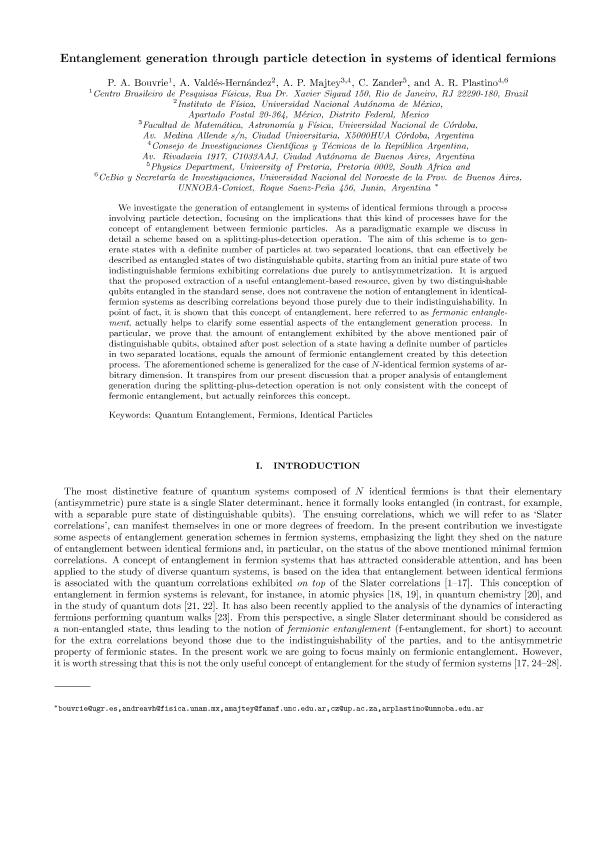Mostrar el registro sencillo del ítem
dc.contributor.author
Bouvrie, P. A.
dc.contributor.author
Valdés Hernández, A.
dc.contributor.author
Majtey, Ana Paula

dc.contributor.author
Zander, C.
dc.contributor.author
Plastino, Ángel Ricardo

dc.date.available
2019-04-30T14:09:22Z
dc.date.issued
2017-08
dc.identifier.citation
Bouvrie, P. A.; Valdés Hernández, A.; Majtey, Ana Paula; Zander, C.; Plastino, Ángel Ricardo; Entanglement generation through particle detection in systems of identical fermions; Academic Press Inc Elsevier Science; Annals of Physics (New York); 383; 8-2017; 401-415
dc.identifier.issn
0003-4916
dc.identifier.uri
http://hdl.handle.net/11336/75296
dc.description.abstract
We investigate the generation of entanglement in systems of identical fermions through a process involving particle detection, focusing on the implications that these kindsof processes have for the concept of entanglement between fermionic particles. As a paradigmatic example we discuss in detail a scheme based on a splitting-plus-detection operation. The aim of this scheme is to generate states with a definite number of particles at two separated locations, that can effectively be described as entangled states of two distinguishable qubits, starting from an initial pure state of two indistinguishable fermions exhibiting correlations purely due to antisymmetrization. It is argued that the proposed extraction of a useful entanglement-based resource, given by two distinguishable qubits entangled in the standard sense, does not contravene the notion of entanglement in identical-fermion systems as describing correlations beyond those purely due to their indistinguishability. In point of fact, it is shown that this concept of entanglement, here referred to as fermionic entanglement, actually helps to clarify some essential aspects of the entanglement generation process. In particular, we prove that the amount of entanglement exhibited by the above mentioned pair of distinguishable qubits, obtained after post-selection of a state having a definite number of particles in two separated locations, equals the amount of fermionic entanglement created by this detection process. The aforementioned scheme is generalized for the case of N-identical fermion systems of arbitrary dimension. It transpires from our present discussion that a proper analysis of entanglement generation during the splitting-plus-detection operation is not only consistent with the concept of fermionic entanglement, but actually reinforces it.
dc.format
application/pdf
dc.language.iso
eng
dc.publisher
Academic Press Inc Elsevier Science

dc.rights
info:eu-repo/semantics/openAccess
dc.rights.uri
https://creativecommons.org/licenses/by-nc-nd/2.5/ar/
dc.subject
Fermions
dc.subject
Identical Particles
dc.subject
Quantum Entanglement
dc.subject.classification
Otras Ciencias Físicas

dc.subject.classification
Ciencias Físicas

dc.subject.classification
CIENCIAS NATURALES Y EXACTAS

dc.title
Entanglement generation through particle detection in systems of identical fermions
dc.type
info:eu-repo/semantics/article
dc.type
info:ar-repo/semantics/artículo
dc.type
info:eu-repo/semantics/publishedVersion
dc.date.updated
2019-04-15T18:18:03Z
dc.journal.volume
383
dc.journal.pagination
401-415
dc.journal.pais
Estados Unidos

dc.description.fil
Fil: Bouvrie, P. A.. Centro Brasileiro de Pesquisas Físicas; Brasil
dc.description.fil
Fil: Valdés Hernández, A.. Universidad Nacional Autónoma de México; México
dc.description.fil
Fil: Majtey, Ana Paula. Universidad Nacional de Córdoba. Facultad de Matemática, Astronomía y Física; Argentina. Consejo Nacional de Investigaciones Científicas y Técnicas; Argentina
dc.description.fil
Fil: Zander, C.. University of Pretoria; Sudáfrica
dc.description.fil
Fil: Plastino, Ángel Ricardo. Universidad Nacional del Noroeste de la Provincia de Buenos Aires; Argentina. Consejo Nacional de Investigaciones Científicas y Técnicas; Argentina
dc.journal.title
Annals of Physics (New York)

dc.relation.alternativeid
info:eu-repo/semantics/altIdentifier/doi/http://dx.doi.org/10.1016/j.aop.2017.06.004
dc.relation.alternativeid
info:eu-repo/semantics/altIdentifier/url/https://www.sciencedirect.com/science/article/pii/S0003491617301707
dc.relation.alternativeid
info:eu-repo/semantics/altIdentifier/url/https://arxiv.org/abs/1608.03456
Archivos asociados
